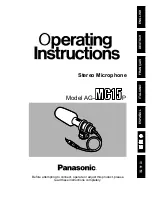
Description
The AT857AMx is a wide-range condenser
microphone designed for quality sound
reinforcement, professional recording, televi-
sion, and other demanding sound pickup
applications. Standing 12.21" above the
mounting surface, its small-diameter alternat-
ing gooseneck design permits highly flexible
positioning while maintaining a smooth, well-
contoured appearance. The AT857AMLx is a
19.00" version of this microphone.
Supplied as a cardioid, the AT857AMx easily
accepts interchangeable elements to permit
selection of angle of acceptance from 100° to
360°.
The microphone features a 9.8' (3.0 m) per-
manently-attached miniature cable. Its free
end connects to the provided AT8533x
power module via internal solderless screw
terminals for simple cable-length adjustment
in the field. It can be powered from any exter-
nal 9V to 52V DC phantom power supply. A
recessed switch in the power module permits
choice of flat response or low frequency roll-
off to help control undesired ambient or
mechanical noise.
The microphone element is enclosed in a
rugged housing with a low-reflectance black
finish. A
5
/
8
"-27 threaded flange allows the
microphone to mate with the threads of a
standard microphone desk or floor stand. A
5
/
8
"-27 threaded stud is also provided so it can
be secured to a permanent mounting surface.
Installation and Operation
Output is low impedance balanced. The
output connector of the power module
mates with XLRF-type cable connectors. The
balanced signal appears across Pins 2 and 3,
while the ground (shield) connection is Pin 1.
Output is phased so that positive acoustic
pressure produces positive voltage at Pin 2,
in accordance with industry convention.
To attach the microphone cable using the
pre-stripped end:
Remove the three screws
from the base of the power module and slide
the outer case off to reveal the circuit board
and screw terminals. Next, slide the case
onto the cable (narrow end first), and tie a
single knot in the cable about 1" from the
tinned ends.
Do not pull directly on the
exposed small wires and shield. Following
Figure 2 on the back of this sheet, attach the
wires to their respective terminals. Make
certain that the terminals are clamped on the
conductors, not on the insulation, and that
there are no loose strands of wire that might
touch other terminals. Replace the case,
being certain that it goes over the case
grounding contact and that the roll-off switch
is accessible. Finish by replacing the three
base screws and testing for proper operation.
To shorten the cable:
Remove the cable
from the module, and cut it to the desired
length (allowing a few extra inches). Next,
after sliding the case back onto the cable, tie
a single knot in the cable about two inches
from the cut end. Following Figure 1 on the
back of this sheet, cut the cable off 1" down
from the top of the knot and carefully remove
1
/
2
" of the outer jacket. Strip the mic cable
wires and attach them to their respective
terminals. Reassemble the module following
the instructions in the previous paragraph.
The provided AT8102 two-stage foam wind-
screen simply slips over the head of the
microphone, effectively reducing wind noise
or “popping” when used extra close.
The small-diameter gooseneck is easy to
manipulate for proper positioning. Heavily
lubricated, it operates smoothly and quietly.
Should the unit become noisy with prolonged
use, apply a light machine oil directly on the
gooseneck area affected.
While a modern condenser microphone is
not unduly sensitive to the environment,
temperature extremes can be harmful. Avoid
leaving the microphone in the open sun or in
areas where temperatures exceed 110° F
(43° C) for long periods of time. Extremely
high humidity should also be avoided.
Architects and Engineers Specifications
The microphone shall be a fixed-charge
condenser with a cardioid polar pattern and a
frequency response of 30 Hz to 20,000 Hz. It
shall be capable of accepting optional inter-
changeable elements for additional polar
patterns. It shall operate from an external 9V
to 52V DC phantom power source. Nominal
open-circuit output voltage shall be 7.0 mV at
1kHz, 1 Pascal. Output shall be low imped-
ance balanced (200 ohms).
The microphone shall have a permanently-
attached 9.8' (3.0 m) miniature cable with a
pigtail output. The pigtail output shall connect
to a power module via internal solderless
screw terminals. The power module shall
include a switch for low-frequency roll-off
and shall terminate in a 3-pin XLRM-type
output connector.
The microphone shall be a small-diameter
alternating gooseneck design, with a 12.21"
(310.2 mm) [19.00" (482.5 mm)] overall
length. Head diameter shall be 0.47" (12.0
mm). The microphone shall include a
5
/
8
"-27
threaded flange to mate with the threads of a
standard microphone desk or floor stand. A
5
/
8
"-27 threaded stud shall be provided for per-
manent installation to a mounting surface.
The microphone weight shall be 3.6 oz (103
grams) [4.6 oz (131 grams)], without cable.
Finish shall be low-reflectance black.
The Audio-Technica AT857AMx [AT857AMLx]
is specified.
AT857AMx
AT857AMLx
CARDIOID
CONDENSER
ADAPTER-
MOUNT
GOOSENECK
MICROPHONES
Frequency Response
LEGEND
Roll-off
12" or more on axis (flat)
Frequency in Hertz
Response in dB
10 dB
20k
10k
5k
2k
1k
500
200
100
50




















